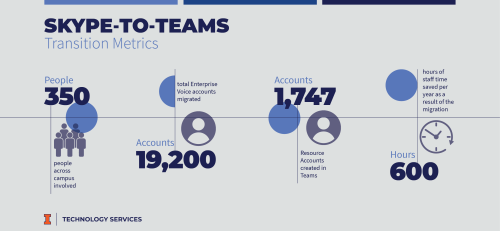With the help of around 350 people in different groups across campus, over 21,000 university accounts were transitioned from Skype for Business to Microsoft Teams as a result of the Skype-to-Teams Transition project this summer.
When Microsoft announced that Skype for Business would no longer be supported after January 2024, the Collaboration Portfolio Advisory Group (CPAG) knew that the university would have to choose a different tool for its primary phone communication and collaboration.
Technology Services led a collaborative effort with numerous groups across and outside the university, allowing students, faculty, and staff to experience an inclusive and safe collaborative environment using Microsoft Teams.
“The Skype-to-Teams Transition project was an essential step in empowering University of Illinois faculty, staff, and students with a primary communication tool that can serve as a platform for collaboration,” said Jacob Myers, Assistant Director at the Big Ten Academic Alliance (BTAA) and Chris Tidrick, Chief Information Officer at the Gies College of Business, both part of the Microsoft Teams Ambassadors.
Myers and Tidrick continue, “[Teams] not only brings in the functionality of calling and chat, but adds a whole portfolio of tools that better suits the diverse needs of campus… it includes streamlined communication, better integration with other tools, enhanced security, and a more inclusive and accessible platform.”
The Teams Ambassadors is a volunteer cohort of IT, business, and other representatives from numerous campus units, formed under the recommendation of the IT Council, a committee part of Illinois IT Governance. The Teams Ambassadors was formed to be the primary point of contact for facilitation, outreach, communication, and training for the Skype-to-Teams migration.
Having worked with the Teams Ambassadors, Myers and Tidrick elaborate on the value of campus collaboration specifically for this project.
“Collaboration and trust go hand and hand with any successful project. However, with a project as far reaching and impactful as the migration of the university’s primary communication platform, it was mission critical. Since early in the planning process, open communication, regular meetings, and shared goals were the building blocks of trust and collaboration.”
Another group exemplifying the power of campus collaboration is CPAG, the group that first identified a need for this transition. Created in 2021, CPAG was an advisory body comprised of IT professionals, operations leaders, and faculty, charged by the Office of the CIO to support the planning for campus collaboration technologies. It delivered recommendations to the CIO to adopt Microsoft Teams as the university’s primary phone communication tool.
Alongside brainstorming and outreach, the technical aspects of the migration were another significant piece. The Skype-to-Teams Steering Committee, a multi-unit IT group, provided technical guidance for the Teams transition. Finally, Technology Services managed the project, led and implemented the technical work, and assisted with training and related communications.
Mike Cervone, Microsoft Teams Phone System Product Owner at Tech Services, offered a technical perspective to the Teams transition. Cervone said that the move to Teams is for the first time “bringing our phone service to an entirely cloud-based solution. This innovation has challenged everybody’s expertise—for both the vendor, Microsoft Azure, and us—in delivering a phone service in a newer way than most people are offering.”
Microsoft Teams offers leading innovation to support university groups in a variety of contexts: on-campus, hybrid, and remote, and for workers using Windows, MacOS, Linux, ChromeOS, Android, and iOS. In addition, the Teams phone service allows the university to change individual features of the service without changing the entire service.
As Myers said, “The Skype-to-Teams transition was more than a technological upgrade: it symbolizes a step towards a more connected, inclusive, efficient campus”—while demonstrating those very values in the process. This collaborative approach involving CPAG, Teams Ambassadors, Skype-to-Teams Steering Committee, and Technology Services helped ensure a smooth transition from Skype to Teams while minimizing disruptions and providing the necessary support for employees to adapt to the new platform effectively.
Skype-to-Teams Transition Metrics
The migration included:
350 people across campus involved
including those from the Project Team, Steering Committee, Teams Ambassadors, Teams Migrations Operations Channel, and other groups across and outside of campus19,200 total Enterprise Voice accounts migrated
75 Teams Channels or Chat Channels created to facilitate the migration
1,747 Resource Accounts created in Teams
that are unaffiliated with users, but which enable calling functions. Resource accounts are often used in situations where numerous people may pick up a call (i.e. a help desk).
As a result of the migration:
600 hours per year saved
that staff (previously spent on supporting servers) can now use for higher-value activities40+ physical and virtual servers will be decommissioned
because of the shift from using servers to a cloud-based infrastructure
